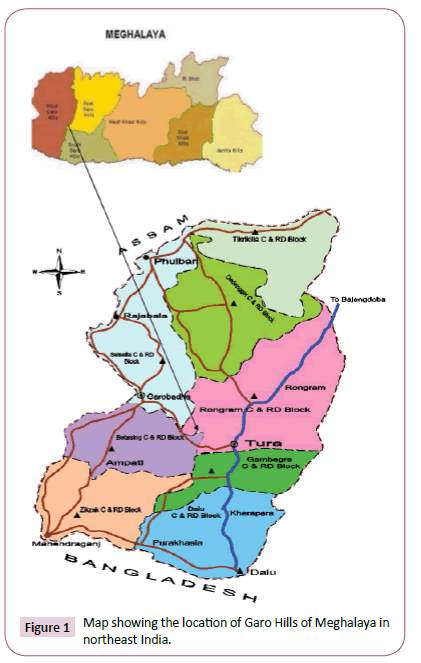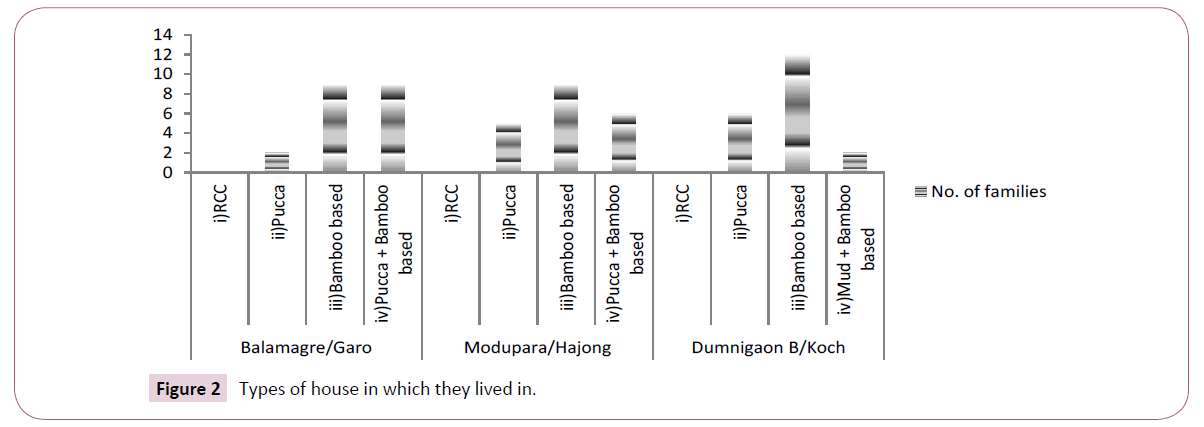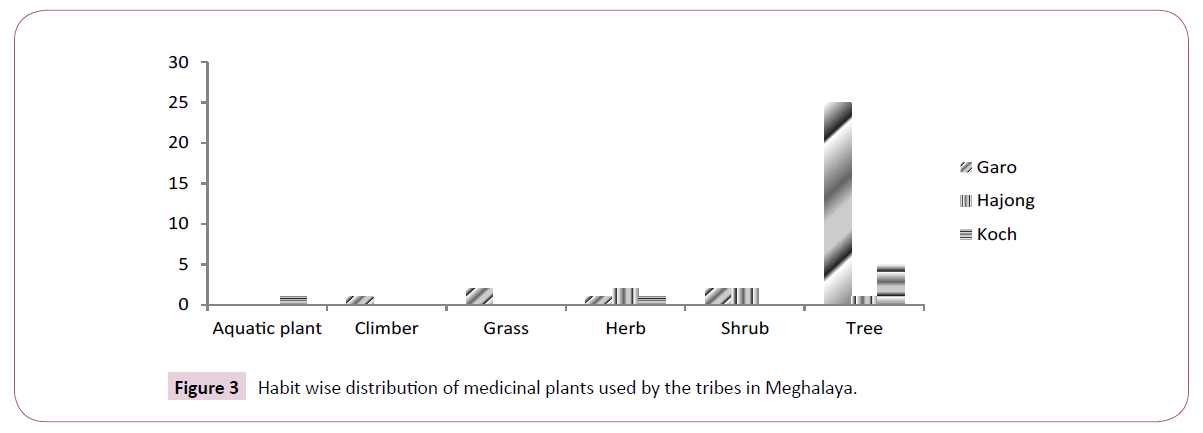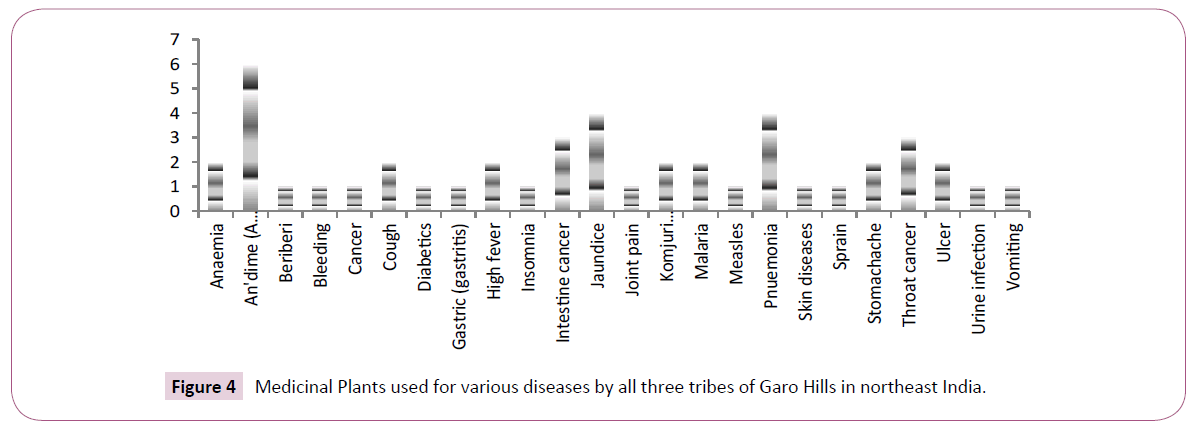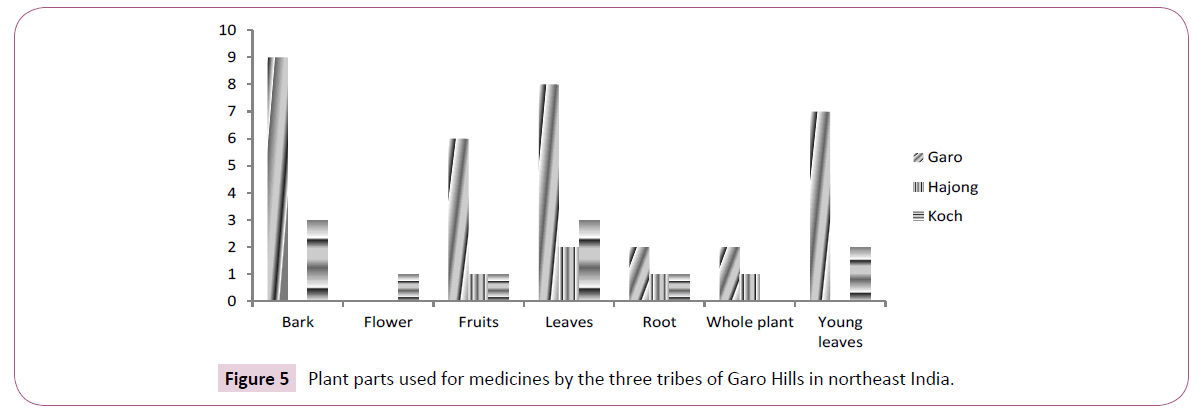ISSN : 2348-9502
American Journal of Ethnomedicine
Utilization Pattern of Medicinal Plants by Different Tribes of Garo Hills of Meghalaya,North-East India
Antica Jarangchi T Sangma and Sahoo UK*
Department of Forestry, School of Earth Sciences & Natural Resources Management, Mizoram University, Aizawl- 796004, India
- *Corresponding Author:
- Sahoo UK
Department of Forestry
School of Earth Sciences & Natural Resources Management
Mizoram University, Aizawl-796004, India
Tel: 03892330654
E-mail: uksahoo_2003@rediffmail.com
Received Date: October 28, 2016; Accepted Date: December 28, 2016; Published Date: January 10, 2017
Citation: Sangma AJT, Sahoo UK. Utilization Pattern of Medicinal Plants by Different Tribes of Garo Hills of Meghalaya, North-East India. Am J Ethnomed. 2017, 4:1.
Abstract
A study was carried out in three rural villages of Meghalaya in northeast India inhabited by Garo tribes in Balamagre village, Hajong tribe in Modupara and Koch tribe in Dumnigaon B. Extensive field visits were made during January to February, 2013 and revisited during November to December, 2015 to document the indigenous uses of medicinal plants by the different tribes of Garo Hills, Meghalaya and to understand the socio-economic profile of these tribes who are closely attached to the forest. A total of 38 medicinal plants belonging to 27 families and 36 genera were recorded and were found to cure 24 diseases in the study areas. The tree species contributed maximally to the traditional uses of medicinal plants and the bark portion was mostly in the majority of cases for medicinal preparation.
Keywords
Socio-economic livelihood; Medicinal plants; Garo; Hajong; Koch; Garo hills; Meghalaya
Introduction
Use of traditional medicine is rapidly growing worldwide [1]. The practice of ethno medicine as an integral part of the culture of indigenous people in many parts of the world has a close interface with local ecosystems and cultural landscapes [2,3]. In India, medicinal plants occupy important positions in the sociocultural, spiritual and medicinal arena of rural people [4]. The hilly sub mountain ranges of Western Ghats contain valuable ethno medicinal plants in villages. Ethno medicinal plants of the region have been used for the treatment of various diseases. Jadhav [5] reported 21 plant species belonging to 15 families were used for treating various diseases. According to Shaikh et al. [6], the plants like Terminalia chebula, Moringa oliefera, Tinospora cordifolia etc. are extensively used in ayurveda as they possess potential anticancer activity. The role of Indian medicinal plants and the various photochemical may be treated effectively for cancer.
North East states of India are one of the richest repositories of medicinal and aromatic plants in the world [7-9]. This region has high medicinal plant diversity due to variance in topography and physiognomy [10]. Numerous wild and cultivated plants play a very important and vital role among cultures. Studies on folk medicines through ethno botanical surveys are also gaining importance in the region [11]. Forty ethno medicinal plants were recorded for the 1st time from Indo-Burma hotspot region (Mizoram, NE India) of particular ecological relevance [12]. Some medicinal plants are used by various ethnic tribes for both food as well as medicine. For example Paederia foetida is a case and because of its therapeutic properties relate to the gastrointestinal system and suggest its potential utility for gastrointestinal ailments. P. foetida is promising as a remedy for life-style related conditions, especially treatment of ulcers [13].
The Garo Hills of Meghalaya are very reach in natural resources. The most important natural resources on which the economy of the state is largely dependent upon are forests, minerals and water resources. Among all the natural resources, forests contribute maximum to the state’s economy [14]. Due to the diverse climatic and topographic conditions Garo Hills forests support a vast floral diversity [15]. Garo Hills societies are predominantly dependent on the forest resources for their livelihood [16,17]. Survey on the ethno medicines by the Garo tribe of Kamrup District, Assam, has revealed that some diseases are cured by using a single plant. For example, Boerhavia diffusa is used for control of swelling of feet during the period of pregnancy. However, Zingiber officinale is also used as in the treatment of asthma [18]. According to the study made by Sharma et al. [19], in North Garo Hills, Meghalaya, trees were the main sources of medicinal plants followed by shrubs, climbers and herbs. The recorded plant species were used for common ailments like headache, stomach problems, cold, cough and fever, jaundice, skin diseases, blood pressure and epilepsy etc. It was observed that knowledge of medicinal plants was confined only to elder people and traditional healers (Ojhas) and source of extraction of these valuable resources were nearby forests.
Garo tribes are one of the matrilineal tribes of North-East India and mostly restricted to the Garo Hills of Meghalaya. They prefer to be called A·chik. The economic life of the Garo tribes revolves around agriculture and farming. The Hajong and Koch tribes are also the scheduled tribes of India. These ethnic tribal people predominantly inhabit in the plain belts of Meghalaya. There is a need to study Medicinal Plants in Garo Hills as there is still very less proper documentation on Medicinal Plants in Garo Hills and there have been still a lot of misinformation which is still need to be corrected.
Materials and Methods
Study site
The study was carried out in Garo Hills of Meghalaya, northeast India which stretches out between 25081ºN to 26011ºN latitude and 890501ʹE to 900591ʹE longitude. It is bounded by Mymensing district and a part of Rangpur district of Bangladesh in the south, by a district of Assam on the North and the West and by the West Khasi Hills district of Meghalaya in the East. It is the home land of the Garos. The Garo Hills have an area of approximately 8,000 sq. kms. Tura is the largest town in Garo Hills. The three rural villages of Garo Hills were selected for the study purpose viz. (a) Balamagre (234 populations), a Garo village, situated 12 kms from Tura town is under Gambegre block, West Garo Hills district. (b) Modupara (180 populations), inhabitaed by some Hajong tribe, situated at a distance of 16 kms from Tura is under Selsella Block, South West Garo Hills district. (c) Dumnigaon (175 populations) inhabitated mostly by a Koch tribe is about 18 kms from Tura and is under Betasing Block in South West Garo Hills district (Figure 1).
Methodology
Three villages namely Balamagre (Garo village), Modupara (Hajong village) and Dumnigaon B (Koch village) were selected for the study of utilization and dependence on Medicinal Plants of the forest dwellers. For this study, extensive field surveys were made during January to February, 2013 and were revisited on November to December, 2015. Socio-economic and Medicinal Plants data were collected through door to door interview using pre tested semi-structured questionnaire as well as group discussion in local dialect. Ethno botanical uses of medicinal plants were collected from three different tribes through village headmen, senior practitioners, and common villagers and also from secondary source of information. Households were interviewed for detail use of medicinal plants, the parts used and the purpose for which medicinal plants used. The medicinal plants were crosschecked with the flora; these were classified family wise, plant part-wise, disease wise, etc. 20 households in each selected villages were sampled randomly. The collected specimens were identified with the help of literature and experts from the Soil and Water Conservation Department, Tura. Wherever necessary the translation of Garo language to English was made using a school dictionary [20].
Results and Discussion
Socio-economic profile
The total population, sex ratio and literacy rate (%) of the three studied tribes are shown in Table 1. The sex ratio of Garo and Hajong shows that males were comparatively more whereas the sex ratio of Koch tribe shows with more of female population. The literacy rate of Hajong tribe was significantly higher than the two other tribes, Garo and Koch tribes. Most of the older people of these tribes were illiterate, majority of the children were still under matriculation while only few of them were above class X. There were also some children who were school dropouts.
Table 1: Basic demographic features of the studied tribes.
| Features | Tribes | ||
|---|---|---|---|
| Garo | Hajong | Koch | |
| Total population | 234 | 180 | 175 |
| Sex ratio | 1000:966 | 1000:942 | 842:1000 |
| Literacy rate (%) | 47.86% | 54% | 44.44% |
The pattern of occupation of the two tribes i.e. Garo and Koch were mainly agricultural activities whereas Hajong tribe were mainly engaged in business especially in handloom which was their main income for daily needs. Besides agricultural activities and business in handloom, some of the family members also involved in daily labour which was also part of their daily income. The occupation of some villagers also include governmental jobs like teacher, driver and job card secretary and others like carpenter, butcher and brick factory worker. Other than these, some villagers used to collect Medicinal Plants for helping villagers and for their income.
Annual income of the households of studied tribes in Garo Hills of Meghalaya depicts that Koch tribe was somewhat better than other tribes in their income. Hajong tribe was more under middle than other two. Garo tribe was comparatively poor.
Figure 2 shows that Koch tribe tends to have better infrastructure than other tribes. Garo tribe was more under pucca + bamboo based. However, overall shows that all the tribes were somewhat same in their infrastructure.
From the survey, it has been found that the Hajong tribe used more number of televisions and the Koch tribe used more number of motors/cycles. Refrigerator users were very less in all the tribes with none by Garo tribe. It has been observed that Hajong tribe has the highest assets whereas Garo tribe has the lowest assets. Among the Garo and Koch community as much as agriculture is important their livestock also has a huge impact on their tradition. On the other hand, the Hajong community does not have much livestock. Only five livestock i.e. 4 poultry and 1 swan has been recorded during the survey. The common livestock domesticated by the Garo community was cattle, pig, goat and poultry whereas in the Koch community was cattle, goat and poultry. The total livestock population was estimated at 178 for Garo community, followed by Koch and Hajong communities having 138 and 5 respectively.
Medicinal plants collected from the forest
Table 2 represents data on ethno-medicinal uses by the three studied tribes of Garo Hills. A total of 38 ethno-medicinal species belonging to 27 families and 36 genera were recorded from the present study. Among the families recorded Fabaceae and Rubiaceae were the largest with 3 species each followed by Poaceae, Myrtaceae, Acanthaceae, Combretaceae, Rhamnaceae, Apocynaceae and Anacardeaceae with 2 species each and the rest with 1 species each. It is observed that Thysanolaena maxima and Cassia fistula were used for curing many diseases.
Table 2: Indigenous traditional knowledge of medicinal plants by the different tribes in Garo Hills, Meghalaya in northeast India.
| Sl. no. | Scientific name | Local name | Common name | Family | Parts used | Diseases |
|---|---|---|---|---|---|---|
| 1 | Aegle marmelos Correa. | Selpri (G) | Bael, Wood apple | Rutaceae | Leaves | Pnuemonia |
| 2 | Albizia chinensis (Osb.). Merr. | Bolpu (G) | Chinese silk tree | Mimosaceae | Bark | An'dime (a female disease after delivery) |
| 3 | Aloe vera (L) Burm f. | Aloevera(G), Dikge kanchan (H) | Aloevera | Asphodelaceae | Leaves | Urine infection |
| 4 | Artocarpus lakoocha Roxb. | Arimu (G) | Monkey Jack | Moraceae | Fruit | Anaemia |
| 5 | Averrhoa carambola L. | Amillenga (G) | Carombola, Starfruit | Oxalidaceae | Fruits and leaves | Jaundice |
| 6 | Azadirachta indica Juss. | Neem (G) | Neem | Meliaceae | Leaves | Skin disease |
| 7 | Baccaurea ramiflora Lour. | Gasampe (G) | Burmese grape | Phyllantaceae | Fruit | Insomnia |
| 8 | Careya arborea Roxb. | Gimbil (G) | Wild guava | Lecythidaceae | Bark | An'dime (a female disease after delivery) |
| 9 | Cassia fistula L. | Sinaru (G) | Indian laburnum, Golden shower tree | Fabaceae | Bark and young leaves | Throat cancer, intestine cancer and jaundice |
| 10 | Dendrocalamus hamiltonii Gamble | Wa'nok (G) | Tama bamboo | Poaceae | Young leaves | Komjuri (weakness, fever and reluctance to eating). |
| 11 | Dillenia pentagyna Roxb. | Agatchi (G) | Dog teak, Karmal | Dilleniaceae | Bark | Diabetics and stomachache |
| 12 | Emblica officinalis Gaertn. | Ambare segun (G), Amla (H) | Gooseberry | Euphorbiaceae | Fruit | Ulcer |
| 13 | Erythrina stricta Roxb. (white) | Bolmandal (G) | Corky coral tree | Fabaceae | Leaves | Cancer |
| 14 | Eupatorium canabimum L. | Samsimari (G), Sambangguri (G), Gual (K). | Gravel root, boneset | Asteraceae | Leaves | Bleeding and stomachache |
| 15 | Garcinia kydia Roxb. | Dengadote (G) | Clusiaceae | Bark | Vomiting | |
| 16 | Gardenia campanulata Roxb. | Darechik (G) | Se-thanbaya | Rubiaceae | Root | An'dime (a female disease after delivery) |
| 17 | Holarrhena antidysentirica Linn. | Golmatra (G) | Bitter oleander | Apocynaceae | main root | High fever |
| 18 | Justicia gendarussa Linn. | Dojagipe (G) | Gandarusa,Warer willow | Acanthaceae | Whole Plant | Sprain |
| 19 | Knema linifolia ( Roxb). Warb. Mon. Myrist. | Bolanchi (G) | Myristicaceae | Bark | An'dime (a female disease after delivery) | |
| 20 | Morinda angustifolia Roxb. | Chenong (G), Chengrong (G) | Irula | Rubiaceae | Leaves | Jaundice |
| 21 | Nelumbo nucifera Gaertn. | Mongnal (G), lalbeda (K) | Lotus | Nelumbonceae | Root, leaves and flower | Bleeding |
| 22 | Ocimum sanctum L. | Tulsi (G) | Tulsi | Lamiaceae | Whole Plant | Cough |
| 23 | Oroxylum indicum Vent. | Kering (G) | Broken bones plant, Indian trumpet | Bignoniaceae | Young leaves | Jaundice |
| 24 | Paederia foetida Linn. | Pasim (G) | Chinese fever vine, Stinkvine | Rubiaceae | Leaves | An'dime (a female disease after delivery) |
| 25 | Psidium guayava L. | Komperam (G) | Guava | Myrtaceae | Young leaves | An'dime (a female disease after delivery) |
| 26 | Rauvolfia serpentina (Linn) Benth. Ex. Kurz. | Dogrikme (G) | Apocynaceae | Root | Malaria | |
| 27 | Rhus semialata Murray. | Kitma (G) | Rhus | Anacardiaceae | Fruit | Measles |
| 28 | Spondias pinnata (L.f) Kurz. | Ambaletong (G) | Hog Plum | Anacardiaceae | Fruit and Bark | Jointpain |
| 29 | Stereospernum cheonoides DC. | Bolsil (G) | Fragrant Padri tree | Acanthaceae | Young leaves | Pnuemonia |
| 30 | Swertia chirayita (Roxb. ex Fleming) H. Karst | Chirota (G), Chirotita (H) | Chirayita | Gentianaceae | Leaves | High fever and malaria |
| 31 | Syzygium cumini (L). Skuls. | Chambu (G) | Black Plum | Myrtaceae | Fruit | Anaemia |
| 32 | Tamarindus indica L. | Che'eng (G) | Tamarind | Fabaceae | Leaves | Ulcer |
| 33 | Terminalia belerica Gaertn. | Chirori (G) | Belleric myrobalan | Combretaceae | Bark | Gastric (gastritis) |
| 34 | Terminalia chebula Retz. | Aritdak (G), Hala (K) | Yellow or chebulic myrobalan | Combretaceae | Bark | Throat cancer and intestine cancer |
| 35 | Thysanolaena maxima Kuntze | Simu (G) | Broom grass, Tiger grass | Poaceae | Young leaves | Pnuemonia, Beri beri and Komjuri (weakness, fever and reluctance to eating) |
| 36 | Vitex peduncularis Wall. | Ranggi (G), Ashoi, Silangri (G) | Verbenaceae | Young leaves | Pnuemonia | |
| 37 | Zizyphus mauritiana Lamk. | Angkil (G) | Ber | Rhamnaceae | Bark | Cough |
| 38 | Zizyphus rugosa Lam. | Makbil angkil (G) | Wild jujube, Wrinkled jujube | Rhamnaceae | Bark | Throat cancer and intestine cancer |
The results show that Hajong tribe used 5 medicinal plants while Koch tribes 7 medicinal plants compared to the Garos who used as many as 31 medicinal plants for curing various ailments. This may be related to the traditional knowledge base among the tribes. The Hajong and Koch tribe had less number of local herbal practitioners compared to the Garos in the study area.
The main sources of medicines were from the trees followed by shrubs, herbs, grasses, climbers and aquatic plants (Figure 3). Garo and Koch tribes used more medicines from trees whereas Hajongs used more from herbs and shrubs (Figures 3, 4 and Table 3).
Figure 3: Habit wise distribution of medicinal plants used by the tribes in Meghalaya.
Figure 4: Medicinal Plants used for various diseases by all three tribes of Garo Hills in northeast India.
Table 3: Disease-wise use of medicinal plants by three tribes of Garo Hills in northeast India.
| Diseases | Garo | Hajong | Koch |
|---|---|---|---|
| Anemia | 2 | ||
| An'dime (A female disease after delivery) | 6 | ||
| Beriberi | 1 | ||
| Bleeding | 1 | ||
| Cancer | 1 | ||
| Cough | 2 | 1 | |
| Diabetics | 1 | ||
| Gastric (gastritis) | 1 | ||
| High fever | 2 | 1 | |
| Insomnia | 1 | ||
| Intestine cancer | 3 | ||
| Jaundice | 4 | 2 | |
| Joint pain | 1 | ||
| Komjuri (Weakness, fever and reluctance to eating) | 2 | ||
| Malaria | 2 | 1 | |
| Measles | 1 | ||
| Pneumonia | 4 | ||
| Skin diseases | 1 | ||
| Sprain | 1 | ||
| Stomachache | 1 | 1 | |
| Throat cancer | 3 | ||
| Ulcer | 1 | 1 | |
| Urine infection | 1 | ||
| Vomiting | 1 |
The Garo tribe used more number of medicinal plants from the forest comparing to Hajong and Koch tribe. Garos used more species to cure An’dime (female disease after delivery) but none in both Hajong and Koch tribes. In Koch tribe more species were used for Throat cancer and Intestine cancer whereas Garo and Hajong used none.
Among the 38 plant species, they were mainly used to treat An’dime i.e., a female disease after delivery (6 species), followed by Jaundice and Pneumonia with 4 species each, throat cancer and Intestine cancer (3 species each), Komjuri i.e., weakness, fever and reluctance to eating (2 species) , Cough (2 species), Anemia (2 species), High fever (2 species), Malaria (2 species), Stomachache (2 species), Ulcer (2 species), Bleeding (1 species), Vomiting (1 species), Skin disease (1 species), Urine infection (1 species), Beriberi (1 species), Cancer (1 species), Diabetics (1 species), Insomnia (1 species), Joint pain (1 species), Measles (1 species), Sprain (1 species) and Gastric (Gastritis) with 1 species (Figure 4).
A plant part used mostly by Garo and Koch tribes was bark whereas Hajongs used mostly from the leaves. Most part of the plants used was highest in Garo tribe except for flower which is none in Garo tribe and 1 in Koch tribe (Figure 4). Parts of the plant mostly bark, leaves, young leaves and fruit were used for preparation of traditional medicines. The highest part used was bark with 11 species followed by leaves with 10 species, fruits (7 species), young leaves (7 species) root (4 species), whole plant (2 species) and flower with only 1 species (Figure 5).
The present study showed that the literacy rate and employment of the study areas are still low. Therefore to alleviate their socioeconomic conditions, they should be supported with better educational and employment opportunities. It was also observed that these people are the repository of traditional knowledge regarding processing and use of large numbers of plants, which could be documented and utilized with proper modifications to improve their economy. By doing so, their dependency on forests can be reduced, together with imposing limits on the loss of biodiversity and overexploitation of natural resources (Figure 6).
In the present study, 38 medicinal plants are used for the treatment of various diseases like Anemia, An’dime (A female disease after delivery), beriberi, bleeding, cancer, cough, diabetics, gastric (gastritis), high fever, insomnia, intestine cancer, jaundice, joint pain, komjuri (weakness, fever and reluctance to eating), malaria, measles, pneumonia, skin diseases, sprain, stomachache, throat cancer, ulcer, urine infection and vomiting. In North Garo Hills, Meghalaya, maximum number of plants was used for curing ailments like stomach problem (dysentery, diarrhea and gastric problem), headache and dizziness while minimum number of plants were used to cure diabetes, epilepsy and gall bladder stone [19] whereas in the present study maximum number of plants are used for an’dime (a female disease after delivery) while minimum number of plants for curing beriberi, bleeding, cancer, diabetics, gastric, insomnia, joint pain, measles, skin diseases, sprain, urine infection and vomiting. Plant parts like bark, flower, fruits, leaves, young leaves, roots and whole plants are taken mostly internally or applied externally in the form of decoction or paste. Trees are the main source of medicinal plants in the present study. All the three tribes of Garo Hills depend on medicinal plants for their health. It is observed that Garo tribe is still mostly depended on medicinal plants comparing to the other two tribes.
Conclusion
Medicinal Plants continue to play an important role for the people of Garo Hills, Meghalaya. Therefore, it is extremely essential to conserve the medicinal plants and the indigenous knowledge of Garo, Hajong and Koch tribes for curing various diseases. Special attention is also needed to further document this study systematically.
Acknowledgements
We wish to thank all the villagers who provided information pertaining to their dependence on Medicinal Plants and cooperation during this field visits. The data focus part of the M.Sc. dissertation submitted to Mizoram University, Aizawl.
References
- Bussmann RW, Glenn A (2011) Fighting pain, traditional Peruvian remedies for the treatment of Asthma, Rheumatism, Arthritis and sore bones. Indian Journal of Traditional Knowledge. 10: 397-412.
- Gesler WM (1992) Therapeutic landscapes: Medical issues in light of the new cultural geography. Social Science and Medicine 34: 735.
- Anyinam C (1995) Ecology and ethnomedicine: Exploring links between current environmental crisis and indigenous medical practices. Social Science and Medicine 40: 321-329.
- Kumar M, Sheikh MA, Bussmann RW (2011) Ethno medicinal and ecological status of plants in Garhwal Himalaya, India. Journal of Ethnobiology and Ethnomedicine 7: 32.
- Jadhav RR (2016) Ethnobotanical and athnomedicinal Survey of Kadegaon Tahsil, Sangli (Maharashtra) India. Journal of Medicinal Plants Studies 4: 11-14.
- Shaikh AM, Shrivastava B, Apte KG, Navale SD (2016) Medicinal Plants as Potential Source of Anticancer Agents: A Review. Journal of Pharmacognosy and Phytochemistry 5: 291-295.
- Haridasan K, Rao RR (1985) Forest Flora of Meghalaya. Bishen Singh Mahendra Pal Singh. 1: 450.
- Haridasan K, Rao RR (1987) Forest Flora of Meghalaya. Bishen Singh Mahendra Pal Singh. 2: 937.
- Chakraborty RDB, Devanna N, Sen S (2012) North-East India an Ethnic Storehouse of Unexplored Medicinal Plants. Scholars Research Library 2: 143-152.
- Majumder J, Battacharjee PP, Datta BK, Agarwala BK (2014) Ethno-medicinal plants used by Bengali communities in Tripura, northeast India. Journal of Forestry Research 25: 713-716.
- Hynniewta SR, Kumar Y (2008) Herbal remedies among the Khasi traditional healers and village folks in Meghalaya. Indian Journal of Traditional Knowledge 7: 581-586.
- Rai PK, Lalramnghinglova H (2011) Threatened and less known ethnomedicinal plants of an Indo-Burma hotspot region: conservation implications. Environmental Monitering and Assessment 178: 53-62.
- Chanda S, Sarethy IP, De B, Singh K (2013) Paederia foetida- a promising ethno-medicinal tribal plant of north eastern India. Journal of Forestry Research 24: 801-808.
- Meghalaya Human Development Report (2008) Environmental Issues and Management of Natural Resources Community Participation and Government Intervention in Meghalaya. Government of Meghalaya, Shillong pp: 216-244.
- Anonymous (2010) Meghalaya state introduction.
- Mandal P (2013) A Glimpse of the Garo Tangible Medicine: The Ruga-Garo Picture. Indian Journal of History and Science 48: 603-623.
- Sarma K, Yadav PK (2013) Relentless Mining in Meghalaya, India. Conservation Science 1: 5-12.
- Das C, Kalita P, Teron R, Tamuli AK (2015) Ethnographic study on the etnomedicinal plant of Garo Tribe of Kamrup District, Assam, India. International Journal of Plant, Animal and Environmental Sciences 5: 172-179.
- Sharma M, Sharma CL, Marak PN (2014) Indigenous uses of medicinal plants in North Garo Hills, Meghalaya, NE India. Research Journal of Recent Sciences 3: 137-146.
- Nengminza DS (2001) The School Dictionary, Garo to English. Garo Hills Book Emporium p: 268.
Open Access Journals
- Aquaculture & Veterinary Science
- Chemistry & Chemical Sciences
- Clinical Sciences
- Engineering
- General Science
- Genetics & Molecular Biology
- Health Care & Nursing
- Immunology & Microbiology
- Materials Science
- Mathematics & Physics
- Medical Sciences
- Neurology & Psychiatry
- Oncology & Cancer Science
- Pharmaceutical Sciences
